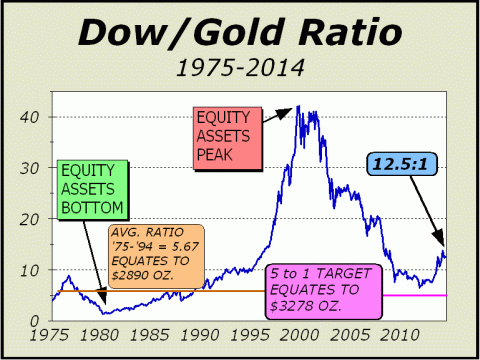Rationales & Targets
The continued weakness in Citigroup (C) and HSBC is increasingly troubling. We also note the chart of Goldman Sachs (GS) now seems to be rolling over. These three behemoths control derivative portfolios with over $115 trillion in notional values, seven times the entire GDP of the country. Weakness in the major banks such as C and BAC was the canary in the coal mine when the previous bubble began collapsing. If the economy were improving as we are told, and the bull market has room to run in both time and price, the lenders should look much better. Is something in the wind?
Stocks remain greatly overvalued, particularly Nasdaq. The Shiller cyclically adjusted P/E ratio (CAPE) was recently as high as 26, exceeded by only the two previous and recent bubbles and the Roaring Twenties. We've discussed the extent of leverage quite often and we are completely mystified why the subject is not front page news. Indeed, it is roundly ignored by the media and only the scantiest—almost grudging—attention is paid by the financial press. The words "new record highs" are news only when used to describe prices, not leverage. Shockingly, we see yet another step in the metamorphosis of the U.S. stock market. And as of their new report, the cash to assets ratio of mutual funds is no longer cited in ICI’s monthly press release, despite being a key indicator going back for decades. It’s almost as if no one wants investors to know how crazy the arena is today; how it depends upon borrowed money and how it depends upon the short term
Virtu Reality
It’s not exactly what we would call a fun read, but HFT firm Virtu’s IPO prospectus filed with the SEC, contains some very interesting information, such as the fact that it lost money on only one day of trading for the 1238 sessions over the five years into the end of 2013 (see http://1.usa.gov/1ne7ttk). This is as good an example of “cheating” (see page four in our February 27th issue) as we can find. HFT firms have changed the playing field dramatically. Despite the constant litany that emanates from HFT firms about providing liquidity and better prices for the public, it is apparent that their claims are a cover for their vigorish. Simply put, the .999 batting average of Virtu and other HFT firms comes at a cost to the public.
New York Attorney General Eric Schneiderman recently announced an investigation into the process that affords “unfair advantages” over the public (see onforb.es/1hURuJA). The situation has become so bizarre that the rules simply so not matter anymore. To wit: despite the SEC’s insistence that insider information cannot be tolerated in any form, HFT firms still seek to step ahead in any way possible. How Thomson Reuters was able to get away with selling HFT firms a two second sneak peek at market moving consumer survey results for so long is proof that the public should probably never hope for “better prices.” After pressure was brought to bear, Thomson Reuters agreed to end the practice but for HFT, when one door is closed, another will surely open. At least the AG’s eyes are finally open.
Gold Still Consolidating
Gold bullion is still performing as expected, consolidating the enormous run up into the September 6, 2011 peak of $1921.50 per ounce. Those who continue to characterize gold in a bear market conveniently forget that the biggest secular bull markets often require substantial corrections and a lengthy consolidation period before resuming their ascent. Examples even include the stock market Crash of 1987. In the year up to the August peak, the Dow was up 54% and had doubled in only two years. It was an astonishing move, and required a substantial correction, in this case, a 36% collapse in only six weeks. It took two years before the Dow registered a new high and another eight months before the old high was surpassed for good.
It is now two-and-a-half years since bullion peaked and the best reason we can afford for the length of the consolidation is the move upwards that preceded the top was even more astonishing. Lest we forget, gold also doubled in two years, had tripled in five years and had risen more than seven-fold in the decade since 911, when we mark the beginning of gold’s super bull market. Despite the huge correction, bullion is still up 264% adjusted for inflation versus the Dow up 25%. We remain convinced that our Dow/Gold ratio targets are reasonable. Technical indications for most gold stocks are negative at this time but we believe weakness can be used to add to long term positions. At the very least, if our thesis proves correct, gold stocks should at least triple—eventually.

ABOUT ALAN M. NEWMAN
Alan M. Newman has been the Editor of CROSSCURRENTS since the first issue was published in May of 1990. Mr. Newman is also a member of the Market Technician's Association and has been widely quoted for years by the financial press, media, and other newsletters and has written articles for BARRON'S.
The newsletter is published roughly every three weeks and focuses on economic and stock market commentary, often covering controversial subjects. Several proprietary technical indicators are usually featured in every issue accompanied by current interpretation. Broad samples of our work can be viewed at http://www.cross-currents.net

